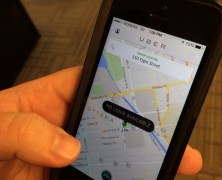By Hayley Chazan Click on the tags to find out more about how Uber works. If you’ve ever been stuck waiting for a cab, you know just how frustrating the taxi system can be. The problem is often worse on weekends and holidays. On New Year’s Eve, it is nearly impossible to hail down a cab, let alone reach the taxi company by phone. Blueline Taxi, Ottawa’s leading cab company, accounts for 80% of the taxi market in the city, meaning limited competition and few choices for consumers. On Oct.1, all of this changed with the appearance in Ottawa of the controversial, and quite possibly illegal, ridesharing service Uber, which has spread rapidly through the United States and Europe as well as Canada. Uber brands itself as a technological company with its business model relying on smartphone apps. It presents consumers with an alternative to taxis and operates as a low-cost ridesharing service. Its low cost is its most attractive feature, according to Ottawa resident Delaney Hoeppner. “Taking a taxi from my apartment downtown to the airport normally costs close to $50. With Uber, depending on the traffic, the fare can often be as low as $30,” she said. Uber has gained a large following on Twitter, with many users actively supporting the ridesharing service. John Baird, the Minister of Foreign Affairs, tweeted about Uber, expressing his frustration about an old-fashioned cab that never arrived. He said there is a need for greater competition in the industry. But Uber attracts criticism, even hostility, everywhere it goes. One concern is that Uber drivers are not licensed. Anyone can sign up to work for Uber if they have a car that is less than 10 years old and can pass a criminal record check. The licensing...

